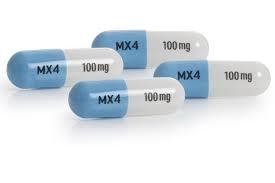Mavorixafor and Alcohol/Food Interactions
There is 1 alcohol/food/lifestyle interaction with mavorixafor.
Mavorixafor Food/Lifestyle
Major Food Interaction
GENERALLY AVOID: Grapefruit products may significantly increase the plasma concentrations and effects of mavorixafor, which is primarily metabolized by the isoenzyme CYP450 3A4. The proposed mechanism is inhibition of CYP450 3A4-mediated first-pass metabolism in the gut wall by certain compounds present in grapefruit. A study examining mavorixafor in combination with the strong CYP450 3A4 and P-glycoprotein inhibitor, itraconazole, suggests an increase in mavorixafor's systemic exposure (AUC) of approximately 2-fold. Clinical data with grapefruit products are not available. Pharmacokinetic interactions involving grapefruit are subject to a high degree of interpatient variability and can also be affected by the product and amount consumed; therefore, the extent to which a given patient may be affected is difficult to predict. Additionally, since mavorixafor is associated with concentration-dependent prolongation of the QT interval, increased levels may potentiate the risk of ventricular arrhythmias such as torsade de pointes and sudden death.
ADJUST DOSING INTERVAL: Food may significantly reduce the peak plasma concentration (Cmax) and systemic exposure (AUC) of mavorixafor. When a single-dose of mavorixafor (400 mg) was administered with a high-fat meal (1000 calories, 50% fat) to healthy subjects, the Cmax and AUC decreased by 66% and 55%, respectively. Similarly, when the same dose was given with a low-fat meal (500 calories, 25% fat) to healthy subjects, mavorixafor's Cmax and AUC decreased by 55% and 51%, respectively. Additionally, a single dose of mavorixafor (400 mg) administered with a low-fat meal to healthy subjects following an overnight fast resulted in a 14% higher Cmax and an 18% lower AUC than those obtained from subjects who fasted for an additional 4 hours after the dose.
MANAGEMENT: Mavorixafor should be taken on an empty stomach after an overnight fast, 30 minutes before food. Patients should be advised to avoid eating or drinking products containing grapefruit, as this could increase the risk of experiencing adverse effects from mavorixafor such as QT prolongation.
References (1)
- (2024) "Product Information. Xolremdi (mavorixafor)." X4 Pharmaceuticals, Inc.
Switch to consumer interaction data
Mavorixafor drug interactions
There are 630 drug interactions with mavorixafor.
Mavorixafor disease interactions
There are 3 disease interactions with mavorixafor which include:
More about mavorixafor
- mavorixafor consumer information
- Check interactions
- Compare alternatives
- Side effects
- Dosage information
- During pregnancy
- Drug class: other immunostimulants
- Breastfeeding
- En español
Related treatment guides
Drug Interaction Classification
| Highly clinically significant. Avoid combinations; the risk of the interaction outweighs the benefit. | |
| Moderately clinically significant. Usually avoid combinations; use it only under special circumstances. | |
| Minimally clinically significant. Minimize risk; assess risk and consider an alternative drug, take steps to circumvent the interaction risk and/or institute a monitoring plan. | |
| No interaction information available. |
See also:
Further information
Always consult your healthcare provider to ensure the information displayed on this page applies to your personal circumstances.


